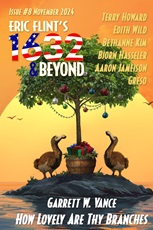 Eric Flint’s 1632 & Beyond #8, November/December 2024
Eric Flint’s 1632 & Beyond #8, November/December 2024
“How Lovely Are Thy Branches” by Garrett W. Vance
“Rites of Passage” by Edith Wild
“A Week Together” by Bjorn Hasseler
“The Diablo is in The Details” by Aaron Jameison Greso
“Emancipation and Education” by Terry Howard
“Stilettos, Part 2” by Bethanne Kim (serial, not reviewed)
Reviewed by Victoria Silverwolf
[Editor’s note: The following is offered by Tangent reviewer Mike Bickerdike as a guide for those not familiar with this magazine’s concept. Eric Flint’s 1632 & Beyond is a magazine comprising stories set in the late Eric Flint’s “Ring of Fire” or 1632 alternate-history universe. For those unfamiliar with the books, the essential concept is that the town of Grantville in West Virginia became transported (by cosmic accident) from our present day to northern Germany in 1632 during the 30 Years War. The book series extends to dozens of novels. The short stories in this magazine are set within that framework.]
“How Lovely Are Thy Branches” by Garrett W. Vance takes place on the island of Mauritius, home to the famous birds known as dodos. In this alternate timeline, the colonists inhabiting the island protect the dodos from extinction and the trees from deforestation. A man and the woman he loves search for a proper Christmas tree on this island of tropical foliage.
The plot is simple, and the story is best described as cute. Readers are likely to find the man’s constant mooning over the woman a bit much.
“Rites of Passage” by Edith Wild is lengthy, features many characters, and has a complex plot, so any synopsis is likely to be misleading. In brief, a violent attack on Grantville causes a crisis at the local hospital and brings back terrible memories to those who survived a massacre in another community.
The scenes at the hospital are vivid and suspenseful, with a great deal of realistic detail. Exposition dealing with reasons for the attack are less involving, at least for those not familiar with other tales set in this universe. The story concludes without a full resolution, suggesting further works to come. This is likely to frustrate those caught up in the plot.
“A Week Together” by Bjorn Hasseler is also long and episodic, but is a much quieter and more leisurely story. A military man spends time with his wife and children between deployments. Among the events that occur are his promotion, reorganization of the military outfit, gatherings with friends and family, discussion of the wife’s new role as advocate for relatives of soldiers, and religious services held at their home.
This peaceful tale can be thought of as a slice of life; or, more properly, given all that happens, as several slices. Nothing very dramatic occurs, which is realistic if not particularly involving. One aspect of the story that may appeal to some readers is the fact that the main characters are persons of deep religious belief who practice their faith actively without becoming stereotypes.
In “The Diablo is in the Details” by Aaron Jameison Greso, a wounded knight and a merchant travel to Venice in order to sell the knight’s jackass and purchase compasses making use of advanced technology from the future. In addition to cash, the fellow selling the compasses demands answers to questions before making a deal. Later the jackass proves to be a problem.
The notion that information is a valuable item of trade is an intriguing one. All the characters are clever and benefit from the transaction. The subplot about the jackass is witty without descending into farce.
In “Emancipation and Education” by Terry Howard, a teenage boy seeks to be legally freed from his father so he can continue in high school rather than face a lifetime at a lowly job. A female pastor, whom the father thinks of as a heretic, helps him achieve his goal.
The above synopsis does not give away too much about the plot, because it is a simple and predictable one. The reader is sure to sympathize with the boy; perhaps too easily, as the situation is heavily stacked against the lad’s intolerant father.
Victoria Silverwolf learned from one of these stories that a female donkey can be called a jennet.